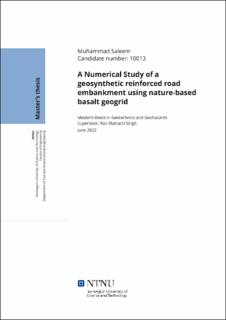| dc.contributor.advisor | Martand Singh, Rao | |
| dc.contributor.author | Muhammad, Saleem | |
| dc.date.accessioned | 2022-10-04T17:19:29Z | |
| dc.date.available | 2022-10-04T17:19:29Z | |
| dc.date.issued | 2022 | |
| dc.identifier | no.ntnu:inspera:116344653:64597235 | |
| dc.identifier.uri | https://hdl.handle.net/11250/3023699 | |
| dc.description.abstract | Sammendrag
I geoteknikk er det utfordrende å bygge veier og andre konstruksjoner på naturlig myk jord. Deformasjonsvansker oppstår ofte på fyllinger og fører til kollaps. Resultater av dette er enten en betydelig setning eller utglidning på grunn av utilstrekkelig skjærstyrke av bløt jord.
Følgelig kan en deterministisk designtilnærming for å forsterke veifyllinger gjennom bruk av natur og unaturlig basert materiale i geosyntetisk geonett løse problemet. Miljøendringer som skjer over hele kloden, er muligens en faktor forbundet med økt risiko når det kommer til skred og bevegelse av store mengder jord og stein. En utfordring vi møter som er nødvendig å overkomme er å redusere bruken av uvennlig materiale. Denne forskningen prøver å finne miljøvennlig materiale som senere kan brukes til å erstatte uvennlig materiale i bygge bransjen. Dette krever en dypere forståelse og karakterisering av de naturbaserte materialene som vanligvis brukes i geosyntetiske geonett-forsterkede prosesser.
Denne forskningen tar sikte på å overvinne utfordringene nevnt ovenfor ved å lage et geosyntetisk geonett ved å bruke naturbaserte materialer for å forsterke en veifylling. Sammenligning av resultatene av naturbaserte og polymerbaserte materialer som brukes i det geosyntetiske geonettet er hovedfokus. Hensikten er å bestemme hvor mye styrking som gis av naturbasert geonett for å strukturere og inkludere den kunnskapen i designtilnærmingen. Denne forskningen brukte PLAXIS 2D plane strain v8.6 med Mohr-Coulomb-modellen for å analysere stabiliteten til veifyllingshellingene mens det ble brukt basaltfiber og polymerbasert materiale i geosyntetisk geonett. Prosjektet tar sikte på å undersøke aktuelle teknikker for å forsterke fyllingsskråninger, begrunne bruk av geonett basert på basaltfiber for å forsterke voll, og bestemme den optimale posisjonen til laget i fyllingen. Resultatene viser at basaltmateriale bør brukes som alternativt materiale i geosyntetisk geonett. Det gir mer motstand mot deformasjon i vegfylling. Denne oppgaven konkluderer med bemerkningen at naturbasert geonett gir 32 % større forsterkning til veifyllingshellinger i stedet for forsterket polymerbasert geonett gjennom sammenligning av tre typer veifyllingshellinger. | |
| dc.description.abstract | Abstract
It is challenging to construct roads and other structures on naturally soft soil in geotechnical engineering. Deformation difficulties frequently occur on embankments and lead to collapse. This is either a significant settlement or sliding due to insufficient shear strength of soft soil.
Deterministic design of reinforced road embankments employing natural and uncultivated materials in geosynthetic geogrid may address the problem. Environmental changings occurring across the globe are possibly a factor associated with increased risk when it comes to landslides and the movement of large amounts of soil and rock. A challenge we meet that is necessary to overcome is to reduce the usage of unfriendly material. This research tries to find environment-friendly materials which can later be used to replace unfriendly materials in the construction industry. This requires a deeper understanding and characterization of the nature-based materials which are commonly used in the geosynthetic geogrid-reinforced processes.
This research aims to overcome the challenges mentioned above by creating a geosynthetic geogrid using nature-based materials to reinforce a road embankment. A comparison of the results of nature-based and polymer-based materials which are used in the geosynthetic geogrid is the focus. Its purpose is to determine how much strengthening is provided by nature-based geogrid to structure and include that knowledge into the design approach. This research use PLAXIS 2D plane strain v8.6 with the Mohr-Coulomb model for analyzing the stability of road embankment slope while using basalt fiber and polymer-based material in geosynthetic geogrid. The project aims to examine current techniques for strengthening embankment slopes, justify using geogrid based on basalt fiber for reinforcing embankments, and determine the optimal position of the layer in the embankment. The results show that basalt material should be used as an alternative material in geosynthetic geogrid. It gives more resistance to deformation in road embankments. This thesis concludes with the remark that nature-based geogrid provides more than 32 % significant reinforcement to road embankment slopes rather than reinforced polymer-based geogrid throughout a comparison of three types of road embankment slopes. | |
| dc.language | eng | |
| dc.publisher | NTNU | |
| dc.title | A Numerical Study of a geosynthetic reinforced road embankment using nature-based basalt geogrid | |
| dc.type | Master thesis | |
